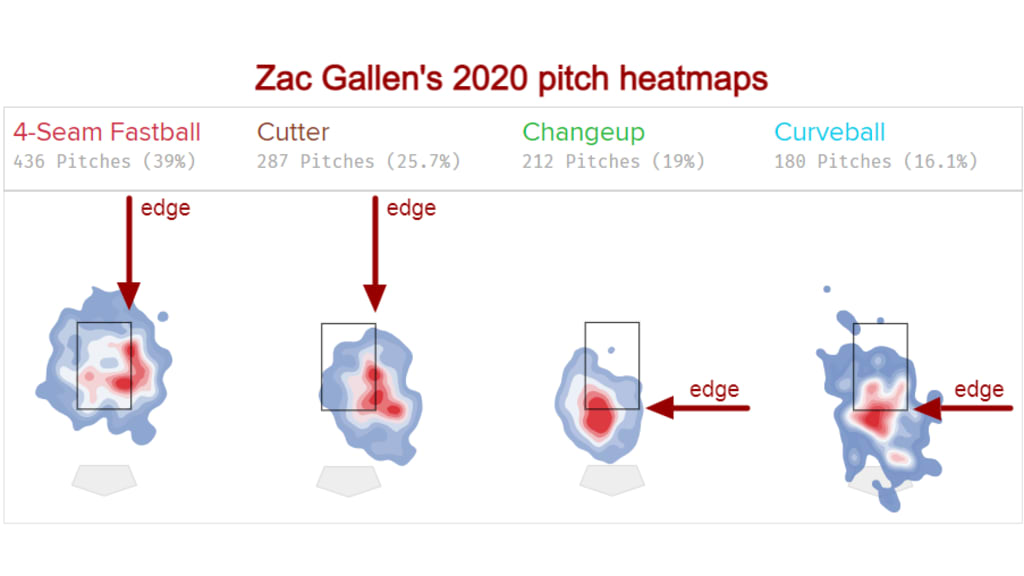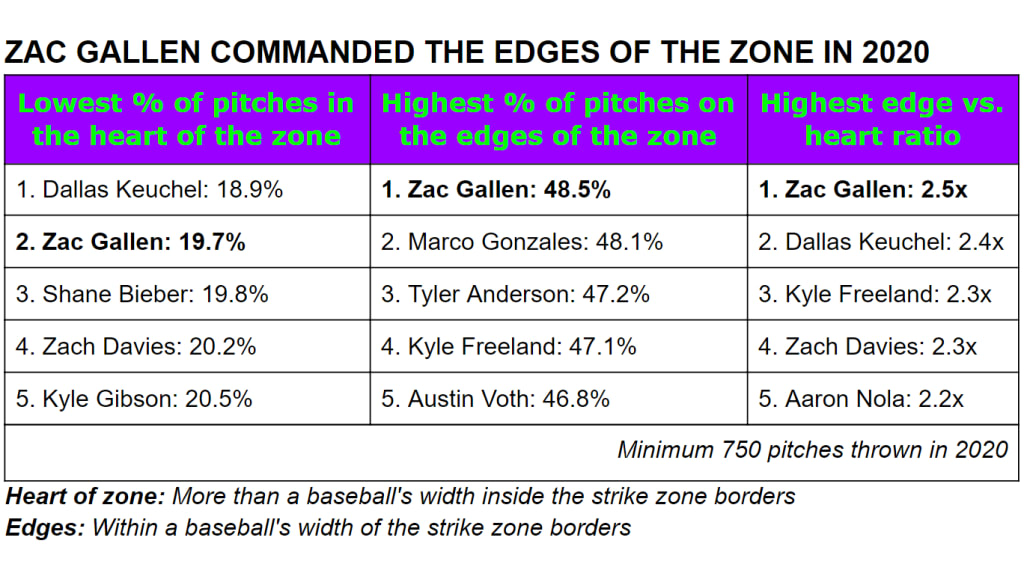Zac Gallen was in the middle of shutting down the Dodgers one night last September when Orel Hershiser, calling the game, made the comparison: he thought the D-backs' young ace was commanding the edges of the strike zone like Greg Maddux.
Yes, the Greg Maddux. And Hershiser, who would know a thing or two about pitching, was right. We have the numbers to back it up, thanks to Statcast's pitch tracking.
Hershiser was also right that Gallen just has to do this for another 15 years. And really, there's only one Maddux. But entering 2021, with a 2.78 ERA over his first two big league seasons, Gallen is a dark horse National League Cy Young Award candidate. And it's not because he has overpowering stuff. It's because he has elite command.
Take a look at his pitch heatmaps from last season. Every single pitch type is concentrated on one of the edges of the zone. That's why he ranks so highly in metrics like STATS' Command+, which has Gallen with top-five command among starting pitchers.

Gallen makes tons of pitcher's pitches -- "nothing overwhelming, but fantastic edgy pitching," as Hershiser phrased it -- and there's always something refreshing about watching a pitcher deal like that even in this golden age of velocity. Here's a closer look at the 25-year-old right-hander.
What does Gallen's command look like in action?
Gallen pounds the edges of the strike zone and avoids the middle. He left fewer than one in every five pitches in the heart of the zone last season, one of the lowest rates in the league. That means he was barely giving hitters anything good to hit. Meanwhile, he hit the edges of the zone nearly half the time -- putting him at the top of MLB in that category.
Or look at it this way: Gallen hit the edges of the strike zone 2 1/2 times more often than he left a pitch in the heart of the zone. That was the biggest difference between pitching to the edges vs. pitching in the heart of any pitcher in 2020.

Gallen commands the edges with everything in his repertoire, every pitch type. In 2020, he was in the shadow zone, as Statcast calls it, on 50.2% of his four-seam fastballs, 43.2% of his cutters, 55.2% of his changeups and 45.6% of his curveballs.
When you can put any pitch right where you want it, that opens a lot of doors. And Gallen knows exactly what he's doing with his deep arsenal.
How does this help him?
Here's the key for Gallen: the edge pitches set up the putaway pitches. Gallen commands the edges of the strike zone so well early in the count that when he gets to two strikes, the hitters are set up to chase whatever he throws at them.
Gallen's edge percentage in all counts before getting to two strikes was 51.4% -- that's over half his pitches covering most situations, and it was the highest rate among starting pitchers. But with two strikes, only 41.1% of his pitches went to the edges.
Instead, 32.8% were thrown to the chase zone -- that means far enough out of the zone where it's not a borderline pitch, but not so far that a hitter can easily lay off. Paralleling what he did with the shadow zone in non-two-strike counts, Gallen had the highest two-strike chase zone percentage among starters. And before two strikes, Gallen only threw chase pitches 22.5% of the time.
On top of all that, depending on which pitch Gallen sets you up with on the edges, what he gets you to chase could also be anything. Most often, it's a curveball that drops below the zone (that's why his overall curveball edge percentage is the lowest). But it could also be a cutter, which he can throw with sharper or loopier paths as a cutter/slider hybrid, or a changeup that fades off the plate, or an elevated four-seamer.
That's why it's so important that his command extends across his repertoire. An early-count four-seamer on the inside edge to a lefty sets up a two-strike cutter in on the hands. A changeup or curveball that lands on the bottom edge tunnels with a riding fastball that carries right over a hitter's bat.
A hard cutter on the outside edge to a righty could be followed by a straight fastball that paints the black again or a slower slider-y cutter that breaks off the plate away. If he drops one curveball onto the bottom of the zone, you might not be able to lay off the next one that drops even further into the chase region. There are just so many possibilities for Gallen to attack and finish off a hitter when he owns the edges of the zone.
So what's next?
There can be a fine line between "commanding the edges" and "nibbling." Gallen succeeds in straddling that line more often than not -- the back-to-back sub-3 ERAs tell you that -- but maybe sometimes he overdoes it.
Pitching in the shadow zone keeps the ball out of the region where a hitter can do the most damage -- the heart -- but the pitches there are borderline. They can be a coin flip whether they're called strike or ball, especially since they might be either just inside or just outside the strike zone borders.
So living in that region to such a high degree also runs a higher risk of walking batters. And that's an area Gallen could maybe make an adjustment.
It's hard to question all his excellent numbers -- the 2.75 ERA and 10.3 K/9 last season speak pretty loudly for themselves. But Gallen can get in trouble with walks at times. He's issued four or more walks in a game six times in his 27 big league starts, including five or more walks four times.
There are probably opportunities for him to go after hitters more aggressively. Even when he's behind in the count, for example, Gallen is still going to the edges over half the time. If you make your pitch, great; you stop hitters from jumping all over you even in hitter's counts. But if you're just a little off, not so great; you issue too many free passes.
There's a time and place for every pitcher to attack the zone. If Gallen gets even better at picking his spots, he vaults even higher into the Cy Young mix. But make no mistake, with the command he has, he's already an ace.
